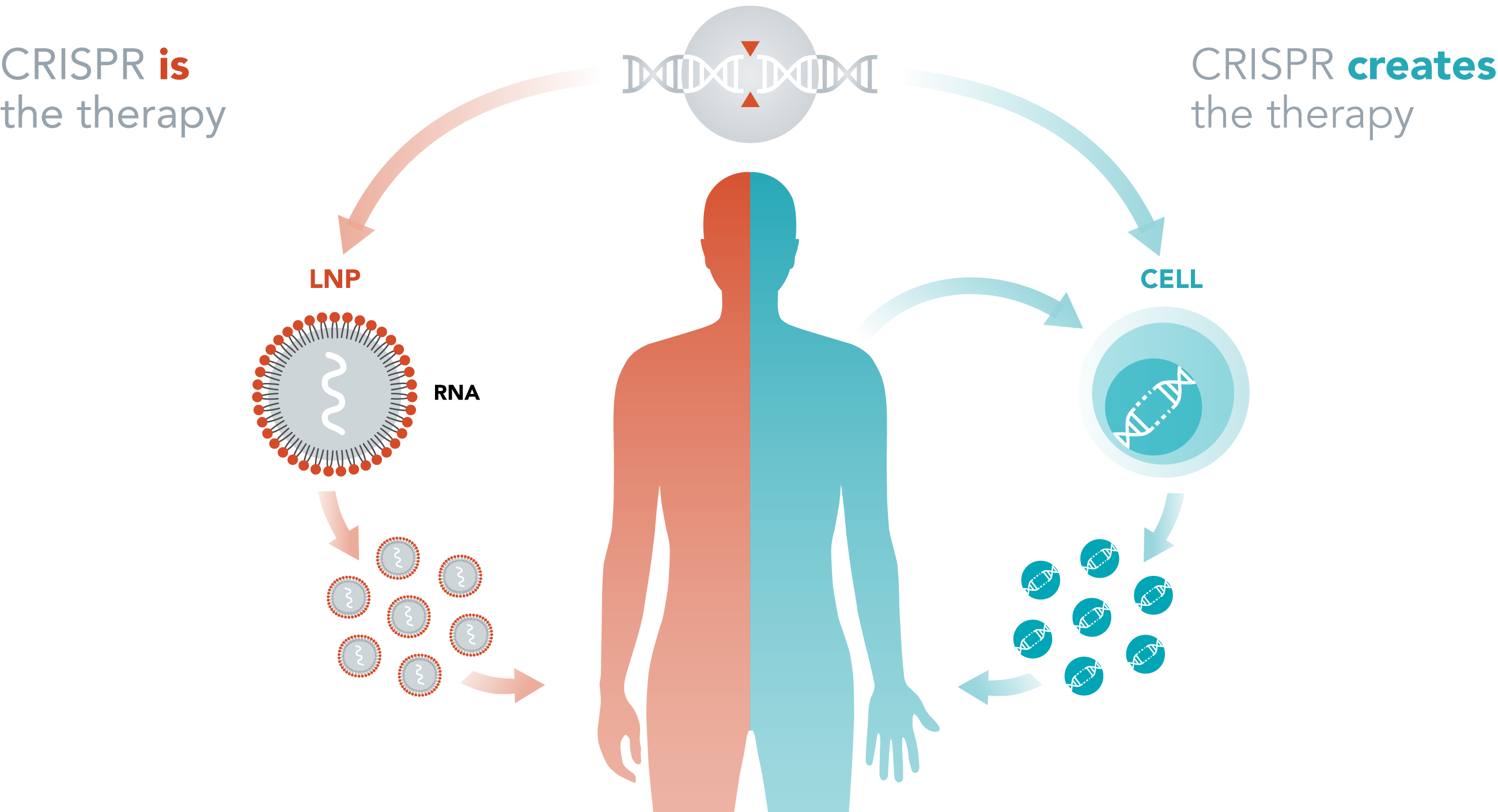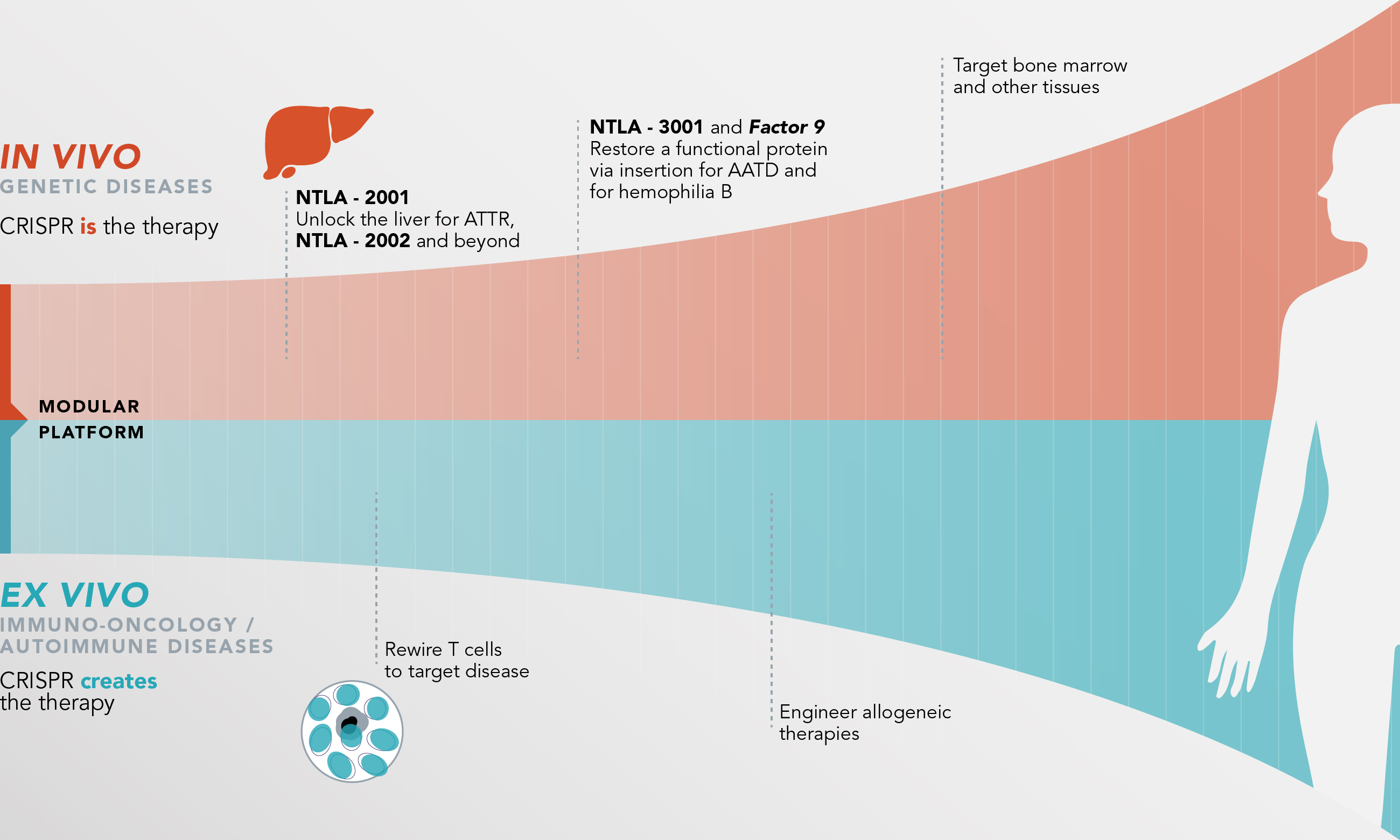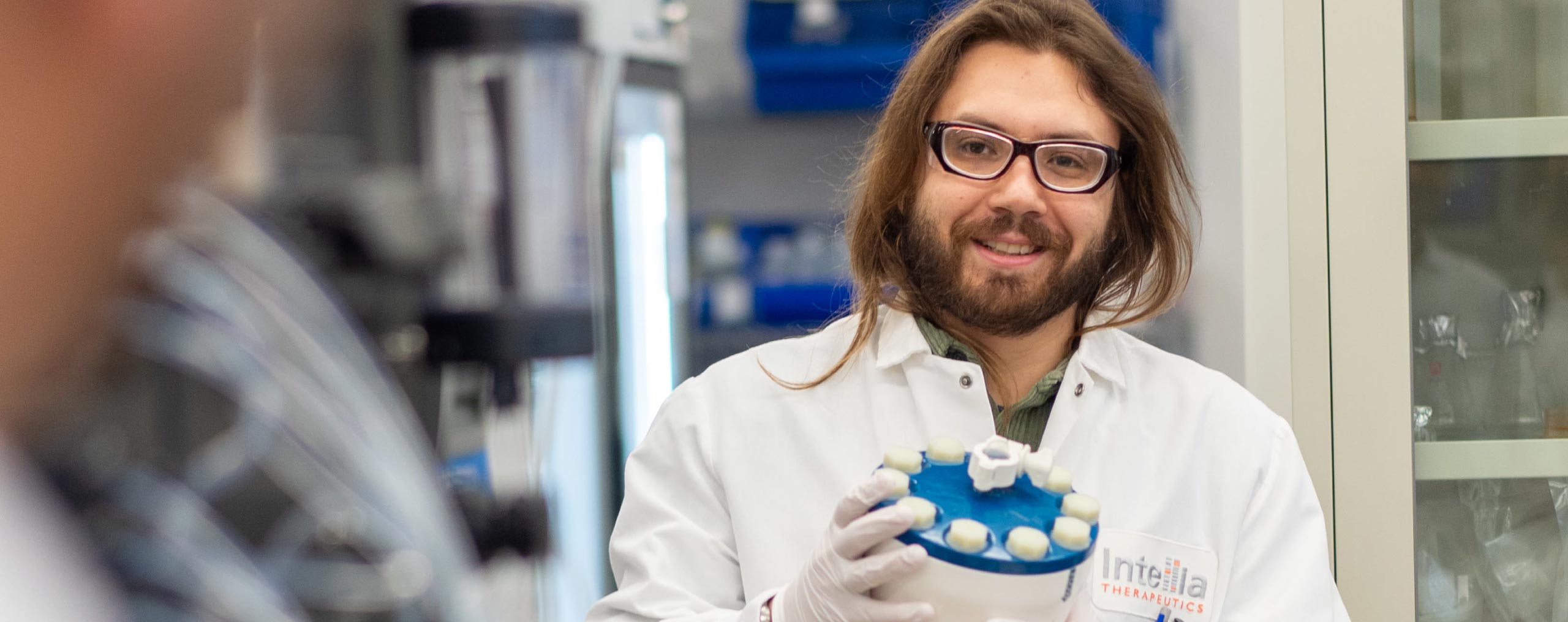Intellia is building a full-spectrum, product-driven biotechnology company dedicated to developing potentially curative gene editingAlso called genome editing. Gene editing collectively refers to a set of technologies, including CRISPR/Cas9, which can be used to cut and modify DNA. Gene editing uses systems to make the DNA change inside the cell. These cells can be edited in the body (in vivo) or outside the body (ex vivo) from a patient or donor. therapies.
Intellia’s Modular Platform
In Vivo
Genetic Diseases
On the in vivoMeaning “within the living,” this type of therapy is administered directly into the patient, targeting the cells and editing the genome from inside the body. side, our systemic lipid nanoparticleAlso known as LNP. LNPs are fat-based molecules that are the basis of Intellia’s CRISPR/Cas9 delivery platform. In Intellia’s experimental treatments, an LNP delivers to its target gene a simple, two-part genome editing system: the messenger RNA that encodes the Cas9 protein and the guide RNA that can target a specific DNA sequence. or LNP-based delivery system has the potential to unlock treatment of genetic diseases by selectively knocking out disease-causing genes, introducing targeted insertionInsertion of a new DNA sequence into the genome to manufacture a desired protein using a gene editing technology, such as the CRISPR/Cas9 system. of a functional gene, or both.
Ex Vivo
Immuno-oncology / Autoimmune Diseases
On the ex vivo side, we are focused on engineering T cellType of white blood cell, or leukocyte, essential to the immune system. Intellia is engineering T cells against specific cancer antigens. therapies to provide them with particular enhanced attributes that may more effectively treat oncological and autoimmune diseases. Our approach is to reproduce natural cell physiology to improve safety and efficacy by engineering cell therapiesType of therapy where engineered cells are transferred into a patient’s body to grow, replace or repair damaged tissue, or perform another desired function. Cells used in these therapies may originate from a healthy donor (allogeneic cells). A common type of cell therapy is blood transfusions, where red blood cells, white blood cells and platelets from one or more donors are transferred into the body of a patient. that are more precise, potent and persistent.

Strategy
Here’s what we are doing to make CRISPR-based genomeA genome is an organism’s complete set of DNA, including all of its genes. Each genome contains all of the information needed to build and maintain that organism. In humans, a copy of the entire genome—more than three billion DNA base pairs—is contained in all cells that have a nucleus. editing a reality:
Develop CRISPR Potential
Focus on indications that enable us to fully harness the potential of the CRISPRAdapted from a naturally occurring bacterial immune system, CRISPR is an acronym for Clustered Regularly Interspaced Short Palindromic Repeats. One of the proteins in the CRISPR system is known as CRISPR-associated 9 protein or Cas9 protein, which cleaves the DNA. Researchers have co-opted the bacterial CRISPR system to make specific changes in the DNA of humans, other animals and plants. CRISPR was first harnessed in 2012 as a genome editing tool in the lab. More recently, scientists have begun engineering and testing CRISPR systems to be very specific to a desired genetic target. system to broad patient populations
Pursue new therapies and delivery technologies
Aggressively pursue in vivoMeaning “within the living,” this type of therapy is administered directly into the patient, targeting the cells and editing the genome from inside the body. liver indications to rapidly develop therapeutics with customized modular delivery technology and expand our ex vivoAlso referred to as a cell therapy. In an ex vivo therapy, cells are removed from the body for modification. Modification is done by administering therapy directly to the cells before they are returned to the body. In the case of ex vivo CRISPR/Cas9 therapies, CRISPR/Cas9 is used to modify cells to repair them to their desired functions. The engineered cells are then administered to the patient so they can treat a particular disease. engineered cell therapiesType of therapy where engineered cells are transferred into a patient’s body to grow, replace or repair damaged tissue, or perform another desired function. Cells used in these therapies may originate from a healthy donor (allogeneic cells). A common type of cell therapy is blood transfusions, where red blood cells, white blood cells and platelets from one or more donors are transferred into the body of a patient. on immuno-oncology and autoimmune diseases
Build Key Partnerships and Collaborations
Maintain strategic partnerships to accelerate clinical development and advance CRISPR-based therapeutics
Improve CRISPR Technology
Grow our technological leadership position by developing improvements on all aspects of the CRISPRAdapted from a naturally occurring bacterial immune system, CRISPR is an acronym for Clustered Regularly Interspaced Short Palindromic Repeats. One of the proteins in the CRISPR system is known as CRISPR-associated 9 protein or Cas9 protein, which cleaves the DNA. Researchers have co-opted the bacterial CRISPR system to make specific changes in the DNA of humans, other animals and plants. CRISPR was first harnessed in 2012 as a genome editing tool in the lab. More recently, scientists have begun engineering and testing CRISPR systems to be very specific to a desired genetic target. technology
Unlocking the Full
Potential of CRISPR



